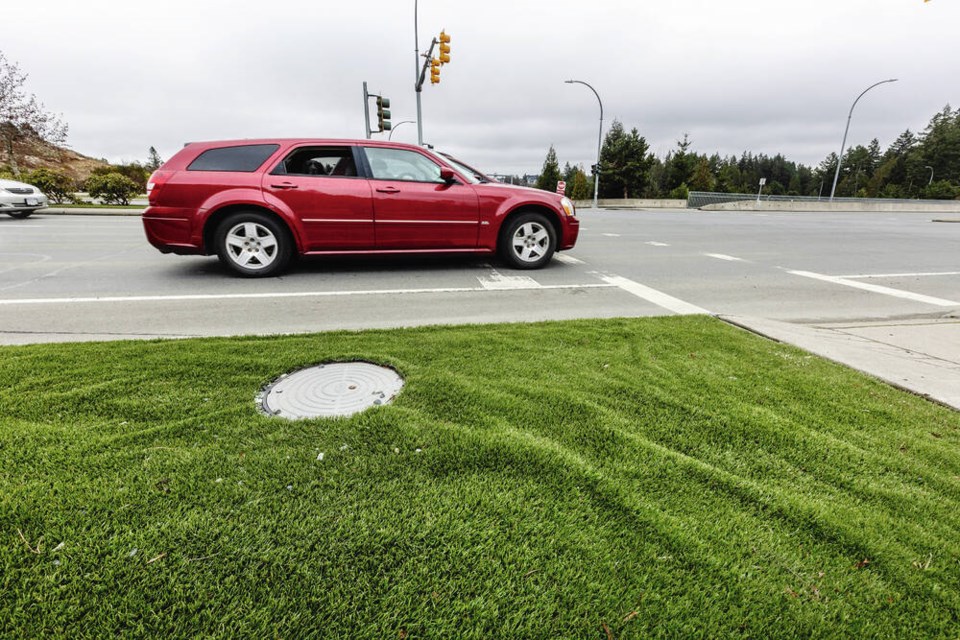Langford’s requirements to use fake grass on boulevards and some property frontages have been turfed.
Five years after previous mayor Stew Young and his council made artificial turf an official policy, Langford’s new council decided Monday it’s cheaper and more environmentally friendly to go with the real thing, or with alternatives such as drought-resistant or native plantings.
But the city won’t be ripping up kilometres of turf or outlawing faux-grass installations.
Council unanimously decided to remove artificial turf requirements in a future omnibus bylaw amendment following a staff report that said anticipated savings using turf were not being met amid “generally negative” feedback from residents.
The report said to install artificial turf, the cost is split between the city and developer 65/35. The city pays the larger amount and is responsible for all of the costs to replace the turf once it reaches the end of its life in 10 to 15 years.
Prices of artificial turf and installation have shot up 64% over the past five years to $133 per square metre, due to inflation and supply issues, according to staff. Sod prices have also spiked due to last year’s flooding in the Lower Mainland, but installed costs are significantly less — about $30 per square metre.
“Switching back to sod installation on city boulevards will result in lower costs to developers compared to artificial turf and no cost to the city for sod installation boulevards,” said the report. “Sod, including soil and irrigation, is installed 100% at the cost of the developer. This works out to be less costly for the developer and less costly for the maintenance, repair and replacement for the city.”
While several residents applauded a move away from artificial turf, others said the previous council’s original intention to protect maintenance workers on busy streets should be kept in mind.
Nicolas Johal pointed to WorkSafe B.C. data indicating that 12 roadside workers were killed in the province last year and dozens more injured while working on busy roadways. “Cars can reach 80 kilometres per hour,” he said. “Roadside work is dangerous. [Turf] makes it safer for workers.”
But there are several concerns arising from the artificial turf, which in some parts of the city is shifting and wrinkling, weeds are sprouting and debris is accumulating.
Staff said artificial turf now requires more than the projected three maintenance visits per year as crews deal with weeds, garbage and accumulations of dog and bird droppings. Crews often have to use pressure-washing and large scrubbers on the turf.
Langford resident Colton Weatherston said artificial turf has its place in areas such as busy highway interchanges and other hazardous areas where worker safety is of primary concern.
“But I think the use of artificial turf should be the exception rather than the rule,” he said. “Its appearance is certainly subjective but, considering we are in a climate crisis and we’re trying to be stewards of the environment, it probably isn’t the best idea to be installing plastic instead of more natural grass.”
Mayor Scott Goodmanson said the decision was not about removing existing turf. “This is removing artificial turf requirements. Right now we have to put [turf] in. This is moving forward and not ripping up the roads right now,” he said.
Coun. Lillian Szpak said she was happy council made an “evidence-based decision.”
“I think we want to be aware of the total picture when we’re looking at the [removal] of turf after it’s aged out and not only making a good economic decision but as well as a social and environmental decision,” said Szpak.
Szpak said she favours removing the large swaths of artificial turf on West Shore Parkway and in front of the Belmont site on Jacklin Road. “Those are the ones I hear about, those are the ones that bother me the most because they are large carpets where we could have had natural vegetation of some sort.”
Coun. Mary Wagner said pollinating plants should be used, and she agreed with some speakers before council who mentioned drought-resistant and native plants and gravel beds on boulevards.
>>> To comment on this article, write a letter to the editor: [email protected]



